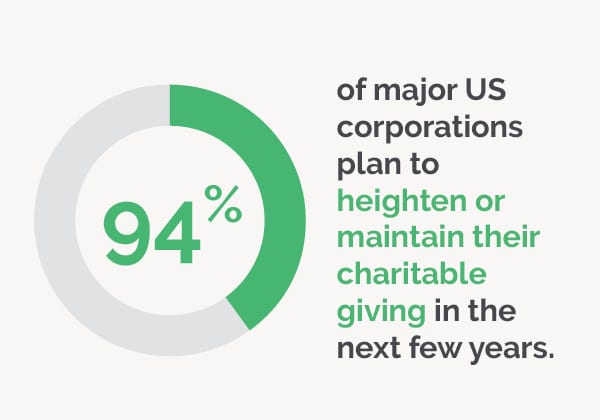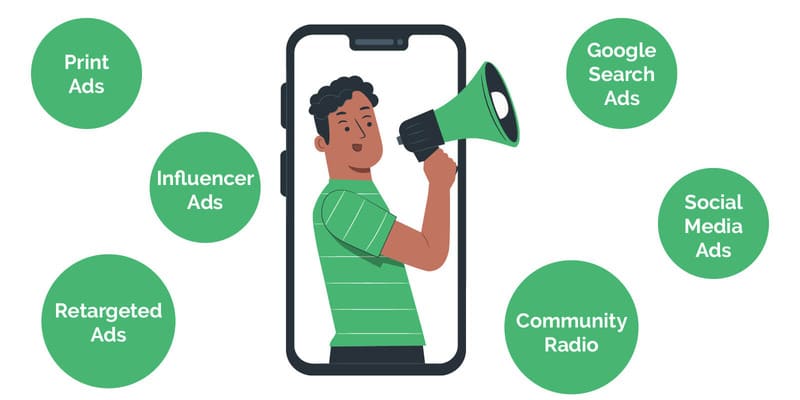
Nonprofits know how crucial marketing is for acquiring supporters, earning donations, and fulfilling their missions. But these organizations also often have tight budgets and limited staff time. Sometimes, you just need extra support to effectively promote your cause—and that’s where sponsorships come in.
Corporate sponsorships can provide your nonprofit with the funding or marketing support you need to thrive. Let’s discuss how to find, secure, and leverage these opportunities.
What Are Corporate Sponsorships?
Sponsorships are one of the many ways businesses can participate in corporate social responsibility practices. To engage their customers and employees and boost their reputation as a socially conscious business, companies develop philanthropic programs in which they financially support nonprofits.
When sponsoring a nonprofit, companies will provide direct support to that individual organization, usually for a specific event or project. This support can take many forms, including:
- Financial: A business provides monetary support by funding a major event or giving a grant to purchase new technology.
- In-kind: Instead of giving you money directly, companies may donate goods like equipment, venue space, or auction items. Or, they could donate professional services such as event planning or catering.
- Media: Some businesses focus their sponsorship on marketing alone. A company might fund your marketing campaign, donate advertising space, or provide in-kind marketing or web design services.
Successful corporate sponsorships benefit both parties—companies get a reputation boost and positive brand awareness, and your nonprofit receives funding and access to a wider audience.
How to Find and Secure Sponsorships
While sponsorships sound ideal, you may be wondering: Are many companies interested in sponsoring nonprofits? Will you be able to find and secure one for your organization?
The good news is that companies love philanthropy. In fact, 94% of major corporations plan to increase or maintain their charitable giving in the next few years. That means there are plenty of available opportunities for organizations like yours.

To find and secure a corporate sponsorship for your nonprofit, follow these steps:
- Start with existing relationships. First, consider companies you’ve partnered with before and businesses that your board members have connections to. Any relationship you already have with a business will help you make a good case for a sponsorship when it comes time to make the ask.
- Research potential sponsors. Look for local businesses and larger companies with shared interests or values that may align with your mission. For instance, a soup kitchen might seek out local restaurants. Once you have a short list, do more research to find things you have in common, such as charitable interests or goals. Then, check their website to see if they’ve sponsored similar nonprofits before.
- Prepare a pitch. Draft a pitch that outlines why the company should sponsor you and what a sponsorship would entail. Explain your mission, detail how your work lines up with their company values, and highlight any existing connections, such as employees who are already involved with your nonprofit.
Remember to reiterate the benefits for businesses when you make your pitch, like the positive reputation boost they’re likely to receive. Then, once you secure a partnership, work out the details of the sponsorship together. Come to an agreement about what exactly the business will provide and for how long, along with how your nonprofit will publicly recognize the support.
Tips for Using Corporate Sponsorships to Market Your Mission
After securing a sponsorship, you can get to work leveraging it to promote your cause! While marketing your mission may look different depending on the type of sponsorship you receive, these basic tips should help.
Communicate Your Mission Effectively
Whether your sponsor donates marketing services or just provides a platform for you to promote your organization yourself, it’s crucial to communicate your mission accurately and effectively. To do so, consider:
- Creating a brand guide for your nonprofit that outlines how to talk about your mission, including any phrases or topics that should be avoided. This will also help you maintain consistency across your marketing materials, boosting brand recognition across channels.
- Incorporating impact stories that bring a human element to your content and give your audience a clear idea of the impact you create. Use real stories of your beneficiaries, donors, or volunteers that demonstrate your mission in action, and include concrete details to bring the stories to life.
If your sponsor creates any joint marketing materials or provides in-kind production and design services, ensure that they portray your mission genuinely. Provide them with your nonprofit’s brand guidelines, impact stories, and existing materials so they have an accurate idea of how you speak about your mission. And don’t be afraid to ask them to change something if it isn’t accurate to your nonprofit’s work.
Maximize the Extra Media Exposure
No matter what the details of your sponsorship are, you’ll gain increased media exposure just by partnering with a business. When they promote your event or campaign website, you’ll get access to a new audience of potential supporters. This is especially true if you secure a corporate sponsor whose audience is already interested in similar causes to your own!
Plus, you may be able to access new marketing channels with your sponsor’s support. These might even include paid advertisements like:

- Print ads
- Influencer ads
- Retargeted ads
- Google ads
- Social media ads
- Community radio ads
As you develop marketing materials for these new channels and audiences, maximize the expanded reach by tailoring your content to the interests of your sponsor’s audience. Lean on values that your nonprofit and the company have in common, and present your cause in ways that would appeal to the business’s customers.
For example, say that your nonprofit works toward marine life conservation and your sponsor is a sustainable clothing company. In this case, you’d want to lean into customers’ interest in sustainability and explain how they can make even more of a difference on the environment by donating to your nonprofit.
Any kind of corporate sponsorship can broaden your nonprofit’s reach and allow you to get your mission in front of more people. But when you choose the right business to partner with and thoughtfully plan out your marketing strategies, you and your corporate sponsor can achieve great things together.


0 Commentaires